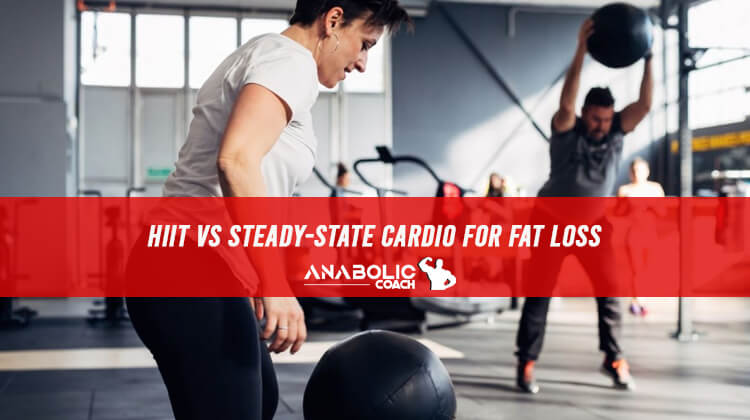It comes as no surprise that many people around the world are now choosing a more healthy lifestyle than ever before.
Some people have attributed this healthy-conscious awakening to the impact that the COVID pandemic had on the whole world. Others just believe that people generally have a better appreciation for the need to stay fit and healthy as a lifestyle choice as opposed to a sedentary existence.
Whatever the case may be, the need to look good has always been the desire of the average person whether that comes in the form of having an average Joe body type or a more muscular, shredded physique.
The quest for ‘socially acceptable’ physical attributes has led more people down the path of adopting a myriad of workout programs for weight and fat loss.
Today, the two most popular fat loss workout routines in the U.S and indeed the rest of the world are high-intensity interval training or HIIT and steady-state cardio.
What makes these two workouts so likeable amongst fitness fanatics is not just their effectiveness in meeting the cutting expectations of fitness enthusiasts, but the fact that they can both be performed in the comfort of any home.
However, while HIIT and steady-state cardio are both great for anyone looking to achieve a shredded physique while building their stamina and endurance levels, the age-old question of which is better tends to pop up in discussions amongst members of fitness communities (around the world) every now and again.
It is the intention of this article to put this matter to bed by providing salient answers to the HIIT vs steady-state cardio for fat loss debate.
We start off with a review of both workout routines before comparing the two of them.
What Is High-Intensity Interval Training (HIIT) for Fat Loss?
With high-intensity interval training for fat loss you have a workout routine that will see you switch from a short period of lung-bursting exercises to similar intervals of rest or low-intensity recovery.
In performing a typical HIIT session, you may decide to include exercises like cycling, burpees, jumping jacks, or sprints.
When executing each of these exercises, you may spend anywhere from 20 seconds to 60 seconds of non-stop, intense action followed by 20 seconds to 60 seconds of rest time before the next exercise.
Benefits of High-Intensity Interval Training (HIIT)
Some of the key benefits of HIIT include:
#1. Time Management
A typical HIIT session runs for between 15 and 30 minutes making this type of workout fat loss routine a perfect choice for busy people. You can schedule your HIIT sessions early in the morning with sufficient time for you to recover from a session before engaging in your normal daily activities. Be mindful that HIIT sessions can be very intense, so make sure you have enough time to relax and recover after a routine.
#2. Greater Calorie Burn
You tend to burn more calories whenever you run a HIIT session. As a matter of fact, you will not only burn calories during your HIIT, but also after a training session as a result of the afterburn effects of excess post-exercise oxygen consumption or EPOC.
#3. Boost in Metabolism
High-intensity interval training is known to stimulate an increase in metabolism ensuring that a whole lot more calories are burnt even during rest time.
#4. Enhanced Fat Loss
As you engage in a HIIT, your body will resort to using body fat as energy fuel during sessions. You can burn an even greater amount of calories when you run both a HIIT and weight training program.
HIIT Drawbacks
- HIIT is tasking on your muscles and joints, especially if you don’t apply proper form during each exercise. If you are new to HIIT, it is important that you spend sufficient time mastering proper form for each exercise before performing an intense session to avoid preventable injuries.
- Recovery is a must if you want to run a HIIT session as you need to rest and recover after each session to avoid both overtraining and muscular injuries.
What is Steady-State Cardio All About?
With steady-state cardio you engage in moderate-intensity, cardiovascular workouts in which you maintain a relatively steady heart rate all through the duration of a steady-state cardio session.
Some popular steady-state cardio exercises that you can engage in include walking, cycling, swimming, and jogging. When executing a steady-state cardio routine you should aim to consistently maintain a similar pace for anywhere from 30 to 60 minutes.
Benefits of Steady-State Cardio
#1. Boost in Endurance Levels
Steady-state cardio sessions will improve your cardiovascular conditioning which in turn enhances your overall stamina, and endurance levels.
#2. Fat Loss
Many people argue that a steady-state cardio workout is the best cardio for fat burning. However, the truth is studies have shown that you will burn more calories per minute when you engage in HIIT sessions compared to steady-state cardio which tends to gradually burn body fat over a much longer length of time.
#3. Steady-State Cardio involves Low Impact Workouts
If you suffer from muscular and joint problems, then steady-state cardio low impact workouts are just what you need. You can go on a long, steady pace walk which will be great for your cardiovascular health.
Steady-State Cardio Drawbacks
- Steady-state cardio is a time consuming endeavor and may not be suitable for busy people particularly during the week.
- Unlike HIIT that offers you a quicker fat burn in a short period of time, steady-state cardio offers fat burn over a more lengthy period.
- You tend to hit plateaus quicker with steady-state cardio as your body generally adapts to your workouts. If you want better fat burning results you will have to rev up the intensity of your workouts.
HIIT vs Steady-State Cardio for Fat Loss: Which Routine Is Better?
There are four main parameters that we examined in the HIIT vs steady-state cardio for fat loss debate. These four parameters are:
- Calorie burn
- Fat loss
- Sustainability and Time management
Calorie Burn
In comparing HIIT with steady-state cardio when it comes to the total amount of calories you are likely to burn, HIIT has the edge.
With HIIT, you tend to burn a whole lot more calories within a shorter time frame compared to the amount of calories that you could burn with steady-state cardio in a similar length of time.
HIIT sessions promote calorie burn both during and after a session with the latter arising as a result of EPOC.
Fat Loss
It is safe to say that steady-state cardio and HIIT both offer fat loss or cutting gains. However, HIIT sessions are great for burning visceral fat while steady-state cardio is more effective for burning subcutaneous fat.
Visceral fat are those fat stores located around viral organs while subcutaneous fat are those fat stores that are located under your skin.
Sustainability
HIIT sessions are typically short while steady-state cardio routines are lengthy in comparison. HIIT is great if you want to burn body fat quickly, but HIIT sessions cannot be run for a lengthy period of time as it could result in injuries due to the intense demands that HIIT places on both your muscles and joints.
However, with steady-state cardio, you have a workout routine that can be performed over a comparably longer period of time since the intensity of sessions is moderate at best.
Therefore while you could maintain multiple steady-state cardio sessions in a week, the same cannot be said for HIIT.
Time Management
As mentioned already, a typical HIIT routine lasts for between 15 to 30 minutes while a steady-state cardio routine may last for one full hour. So if you are a busy executive looking for a quick workout to burn fat, HIIT and not steady-state cardio is ideally suited to your time demands.

Conclusion
In closing it is clear to see that both workout routines offer great benefits, but may have some limitations as well.
Deciding on which one to choose will ultimately be dependent on your preference, fitness level and goals.
If you are a busy executive looking to sweat it out early in the morning with a quick high intensity routine, then HIIT is just what will meet your needs.
However, if you want a low to moderate intensity, time consuming workout to stay fit whilst you pass the time, then you are an ideal candidate for a steady-state cardio workout program.
But you could achieve optimal calorie burn and fat loss when you combine both HIIT and steady-state cardio in a holistic weekly program that will also include a weight training routine.
You essentially get to combine the advantages of all three workout routines to improve your cardiovascular conditioning, build muscle mass, lose body fat, and enhance your stamina all at once.
For more information on HIIT vs steady-state cardio for fat loss contact an expert for free coaching at Anabolic coach today.



In the above comments I noticed that you recommended peptides in place of steroids for older adults. I’m 71 and I’m looking for a reasonable priced peptide supplement to enhance fat loss and increase muscle tone. Is there a starter stack you could recommend ? I weigh 180# and I’m looking to go to 150-160#.
Hello,
Indeed, peptides are a better option for older adults compared to steroids. They promote cell regeneration, improve muscle recovery, and naturally stimulate hormone production without the unwanted side effects of steroids. Additionally, they support joint health and metabolism, which is especially important with age.
For your goal of fat loss and improved muscle tone, I would recommend semaglutide. However, in order to provide you with a protocol tailored to your profile and specific needs, I would need more information about you.
I invite you to fill out the coaching request form at the following link: https://anabolic-coach.com/free-coaching/
Best regards,